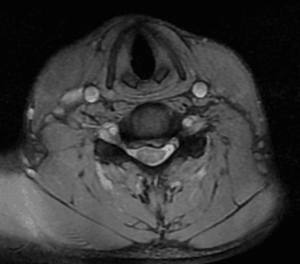
ACDF Surgery
Who is a candidate for ACDF Surgery?
Any person without contraindication and substantial neck and/or radicular pain (arms, hands) that has the following circumstances:
• Cervical Instability
• Cervical Trauma
• Cervical Ossification
• Long term degenerative changes
• Osteoporosis
• Significant facet joint pain component
ACDF contraindications
• Active infection
• Known allergy to medical device components
What is ACDF Surgery?
The cervical anterior approach (ACDF Surgery) is made from the anterior part of the neck through a horizontal incision, generally following a wrinkle or a channel on the neck, frequently on the right side once the patient is put face up on the operating table under total anaesthesia. The incision generally has about 3cm wide except when operating several cervical levels.
Later the surgeon will push aside the trachea, oesophagus and the neck arteries to be able to have access to the anterior cervical spine. The neck muscles are drawn apart to clearly uncover the cervical spine so that the surgeon can determine the affected discs, using intraoperative radiology.
Once identified the affected disk, the surgeon will proceed to a cervical discectomy which consists in extracting the material in the disc as well as the osteophytes which cause the pressure to the spinal cord or are affecting the nerve roots. The mentioned above are the reasons to why the patient suffers from myelopathy or radiculopathy. In most cases the procedure is made through microsurgical technique.
Having freed the nerve roots and spinal cord and checked that there are no residual disc fragments, the surgeon will carry on preparing the bones plates of the adjacent vertebrae in order to place the autologous bone graft or the cervical cages. In the latter case, the disc is filled with fragments of autologous bone graft or artificial bone substitute. Depending on each case, it can be considered screwing an anterior cervical plate inside the vertebrae to strengthen the bone fusion.
The skin in then sutured (intradermal suture) and a subcutaneous drainage is immediately placed and then removed the following day after the surgery.
ACDF Neurosurgery
ACDF can be performed by a neurosurgery specialist (Europe) or Spine Surgeon (USA). In any case you should look for an experienced cervical spine surgeon.
ACDF Duration
The duration of a ACDF is about 1 to 2 hours, however surgeries related to several levels can take up to 3 hours or more.
ACDF Recovery
Once the patient wakes up, he/she will experience some sort of throat pain and some difficulty in swallowing for a couple of days. In some cases the patience might feel pain between the shoulder blades which will gradually diminish. The following day after surgery, the patient can stand upright and walk. It is possible that a soft collar is needed for a several days to improve the post-operation comfort; however in some cases it might takes weeks. For a short period of time the patient might need some simple painkillers.
The patient can leave the hospital within 2-3 days after the surgery, except when 2 level ACDF surgery was performed in or multilevel ACDF surgeries, which in these cases, the patient must remain in the hospital a bit longer before going back home.
In any type of ACDF operation, the patient should avoid driving for a couple of weeks, however, it is crucial that the patients walk as much as possible until achieving his/her optimal walk rhythm. Patients are forbidden to lift up heavy weights during the first weeks and it is advisable not to smoke as recent studies indicate that it affects negatively the complete bone fusion thus diminishing the surgery success itself.
ACDF Recovery time
The patient can return to his/her daily routine after a few weeks post operation, generally after 4 weeks. Going back to their daily routine depends on several factors, but generally it will not take longer than 4 months.
2 level ACDF
In the cases 2 level ACDF, the surgical intervention is basically the same as of a 1 level ACDF Surgery, the only difference is that the surgery takes longer and the recovery time in the hospital takes a day longer.
C5-C6 ACDF
This is most frequent level affected after the C6-C7, which are by far the most common affected levels. Below are the percentages of these affected levels:
C5-C6 – 19 %
C6-C7 – 69 %
The surgical procedure (ACDF) is the same for the other cervical segments as well as the recovery period.
ACDF Surgery Success Rate
ACDF is a successful procedure when it comes to improve or eliminate the radiculopathy (arm pain) caused by a compressed nerve root. Most of the patients are happy with the positive outcome.
ACDF is a less effective procedure when it comes to improve the cervical pain (neck pain) as only 50% of the patients are happy with the positive outcome.
ACDF does not cause a significant loss of cervical movement or its flexibility, however it all depends on the number of levels operated. However, there is a higher possibility that the adjacent segments can become affected, due to the fact that the adjacents level should ompensate the movement initially made by the fused levels.
Sources:
Dr. Vicenç Gilete, MD, Neurosurgeon & Spine Surgeon.
Neurosurgery volumes I–III. Edited by Robert H. Wilkins and Setti S. Rengachary. McGraw-Hill.
Handbook of Neurosurgery. Mark S.Greenberg, Seventh Edition. Thieme.
Last Update [site_last_modified date_format=”Y-m-d H:i:s”]
info@cervicalspinespecialistcenter.com
